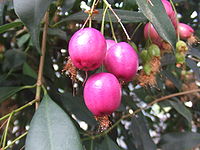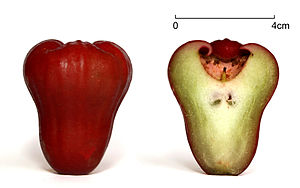- Syzygium
-
Syzygium 
Syzygium malaccense Scientific classification Kingdom: Plantae (unranked): Angiosperms (unranked): Eudicots (unranked): Rosids Order: Myrtales Family: Myrtaceae Subfamily: Myrtoideae Tribe: Syzygieae Genus: Syzygium
R.Br. ex Gaertn.[1]Species About 1100; see text
Synonyms[2] Syzygium is a genus of flowering plants that belongs to the myrtle family, Myrtaceae. The genus comprises about 1100 species, and has a native range that extends from Africa and Madagascar through southern Asia east through the Pacific. Its highest levels of diversity occur from Malaysia to northeastern Australia, where many species are very poorly known and many more have not been described taxonomically. 62 species are found in Australia and are generally known as lillipillies, brush cherries or satinash.[3]
Most species are evergreen trees and shrubs. Several species are grown as ornamental plants for their attractive glossy foliage, and a few produce edible fruit that are eaten fresh or used in jams and jellies. The most economically important species, however, is the clove Syzygium aromaticum, of which the unopened flower buds are an important spice. Some of the edible species of Syzygium are planted throughout the tropics worldwide, and several have become invasive species in some island ecosystems. At times Syzygium was confused taxonomically with the genus Eugenia (ca. 1000 species), but the latter genus has its highest specific diversity in the neotropics.
Contents
Selected species
- Syzygium ampliflorum
- Syzygium amplifolium
- Syzygium andamanicum
- Syzygium anisatum
- Syzygium aqueum – Water Apple, Bell fruit, Water cherry, Watery rose apple
- Syzygium australe – Brush Cherry (Aust.)
- Syzygium aromaticum – Clove
- Syzygium beddomei
- Syzygium benthamianum
- Syzygium bourdillonii
- Syzygium caryophyllatum
- Syzygium chavaran
- Syzygium cordatum – Hute, Waterbessie, undoni, water berry, umSwi
- Syzygium corynanthum – Sour cherry
- Syzygium corynocarpa (A.Gray) C.Muell.
- Syzygium courtallense
- Syzygium crebrinerve – Purple cherry
- Syzygium cumini (L.) Skeels – Jambul, Jambolan, Black plum, Damson plum, Duhat plum, Jambolan plum, Portuguese plum
- Syzygium curanii – Lipote
- Syzygium cyclophyllum
- Syzygium densiflorum
- Syzygium diffusum
- Syzygium discophorum
- Syzygium erythrocalyx – Johnstones River Satinash
- Syzygium fergusonii
- Syzygium fibrosum
- Syzygium fijiense
- Syzygium forte – White Apple
- Syzygium francisii – Giant water gum
- Syzygium gracilipes
- Syzygium guehoi
- Syzygium guineese – Waterberry
- Syzygium hodgkinsoniae – Red lilly pilly
- Syzygium jambos (L.) Alston – Roseapple, Malabar plum, Plum rose, Rose apple, Water apple
- Syzygium luehmannii – Riberry, Cherry Satinash
- Syzygium maire
- Syzygium malaccense (L.) Merr. & L.M.Perry – Malay Apple, Malacca apple, Malay rose apple, Mountain apple, Otaheite cashew, Rose apple, Water apple
- Syzygium makul
- Syzygium manii
- Syzygium micranthum
- Syzygium microphyllum (Syzygium gambleanum is an illegitimate synonym)
- Syzygium minus
- Syzygium moorei – Coolamon
- Syzygium myhendrae
- Syzygium neesianum
- Syzygium nervosum
- Syzygium occidentale
- Syzygium oleosum – Blue Lilly Pilly
- Syzygium oliganthum
- Syzygium palghatense
- Syzygium paniculatum – Magenta lillypilly (Aust.)
- Syzygium parameswaranii
- Syzygium papyraceum (Australia)
- Syzygium patentinerve (endemic to Savai'i & Upolu islands in Samoa)[4]
- Syzygium phaeophyllum
- Syzygium phyllyraeoides
- Syzygium polyanthum (Wight) Walp. – Indian bay leaf, Indonesian bay leaf, Salam leaf, daun salam, Indonesian laurel
- Syzygium pondoense
- Syzygium purpureum
- Syzygium pseudofastigiatum (Australia)
- Syzygium quadrangulatum (A.Gray) Merr. & L.M.Perry
- Syzygium ramavarma
- Syzygium richii (A.Gray) Merr. & L.M.Perry
- Syzygium rotundifolium
- Syzygium samarangense (Blume) Merr. & L. M. Perry – Java Apple, Makopa, Java rose apple, Samarang rose apple, Water apple, Wax jambu, Wax apple
- Syzygium sandwicensis (A.Gray) Nied. – ʻŌhiʻa ha[5]
- Syzygium seemannii (A.Gray) Biffin & Craven
- Syzygium seemannianum[verification needed]
- Syzygium smithii
- Syzygium spathulatum
- Syzygium spissum
- Syzygium stocksii
- Syzygium suborbiculare – Lady Apple
- Syzygium sylvestre
- Syzygium travancoricum
- Syzygium turbinatum
- Syzygium umbrosum
- Syzygium utilis
- Syzygium wolfii
- Syzygium wrightii
- Syzygium xerampelinum (Australia)
- Syzygium zeylanicum – Smaich (Cambodia)
- Syzygium sp. 'Lakeba'
Formerly placed here
- Eugenia syzygioides (Miq.) M.R.Hend. (as S. syzygioides (Miq.) Merr. & L.M.Perry)
- Waterhousea floribunda (F.Muell.) B.Hyland (as S. floribundum F.Muell.)[6]
References
- ^ "Genus: Syzygium R. Br. ex Gaertn.". Germplasm Resources Information Network. United States Department of Agriculture. 2009-01-27. http://www.ars-grin.gov/cgi-bin/npgs/html/genus.pl?11821. Retrieved 2011-01-26.
- ^ Craven, L.A.; Biffin, E. (2010). An infrageneric classification of Syzygium (Myrtaceae). Blumea - Biodiversity, Evolution and Biogeography of Plants. 55: 94–99.
- ^ Eliot Rodger W.; Jones, David L.; Blake, Trevor (2010). Encyclopaedia of Australian Plants Suitable for Cultivation: Volume 9 – Sp-Z. Port Melbourne: Lothian Press. pp. 160–61. ISBN 0-7344-0974-4.
- ^ Whistler, W. Arthur (1978). "Vegetation of the Montane Region of Savai'i, Western Samoa". Pacific Science (The University Press of Hawai'i) 32 (1): 90. http://scholarspace.manoa.hawaii.edu/bitstream/10125/1423/1/v32n1-79-94.pdf. Retrieved 10 July 2010.
- ^ Little Jr., Elbert L.; Roger G. Skolmen (1989) (PDF). ‘Ōhi‘a ha. United States Forest Service. http://www.ctahr.hawaii.edu/forestry/trees/CommonTreesHI/CFT_Eugenia_sandwicensis.pdf.
- ^ "GRIN Species Records of Syzygium". Germplasm Resources Information Network. United States Department of Agriculture. http://www.ars-grin.gov/cgi-bin/npgs/html/splist.pl?11821. Retrieved 2011-01-26.
External links

This Myrtaceae article is a stub. You can help Wikipedia by expanding it.


